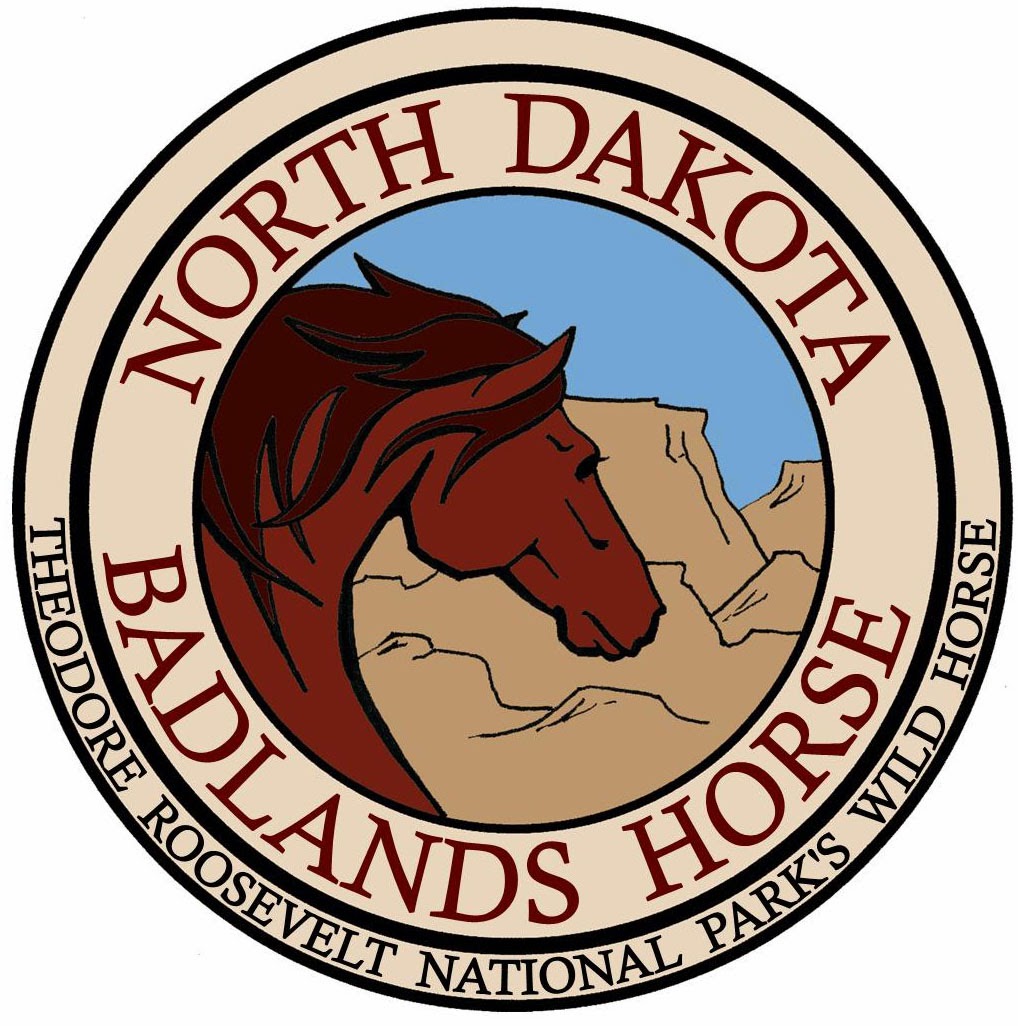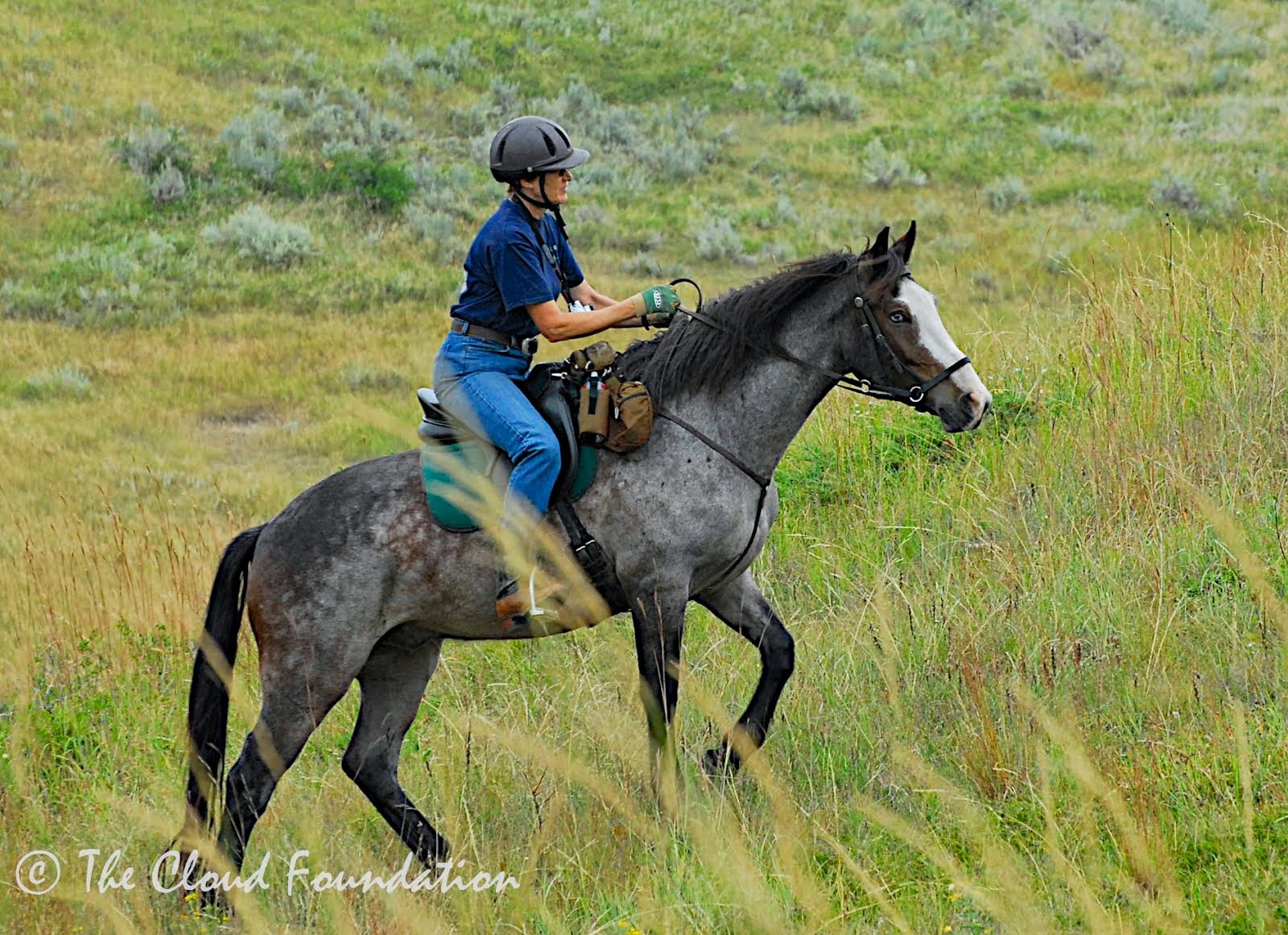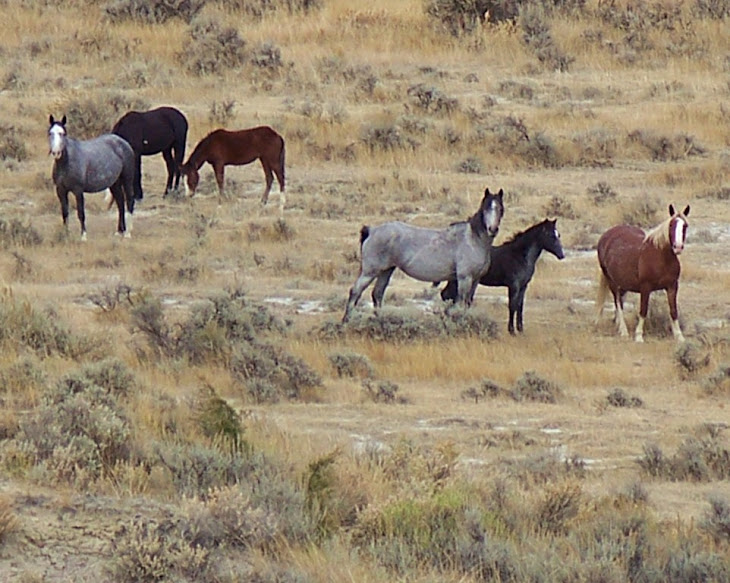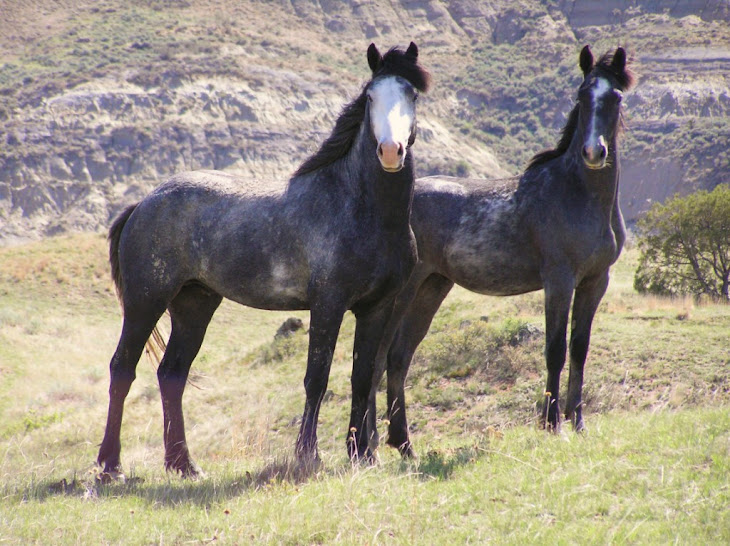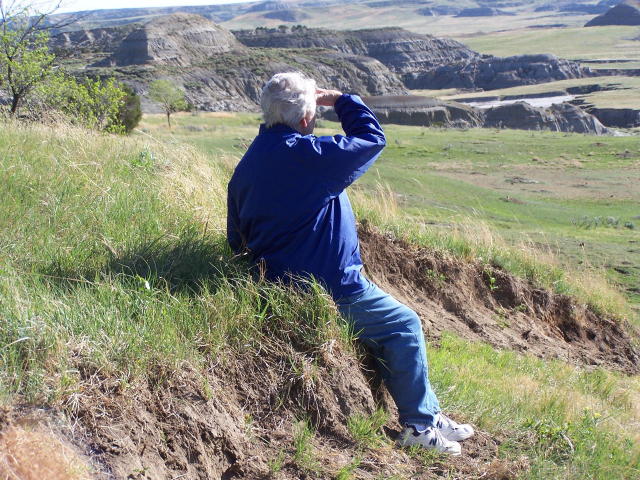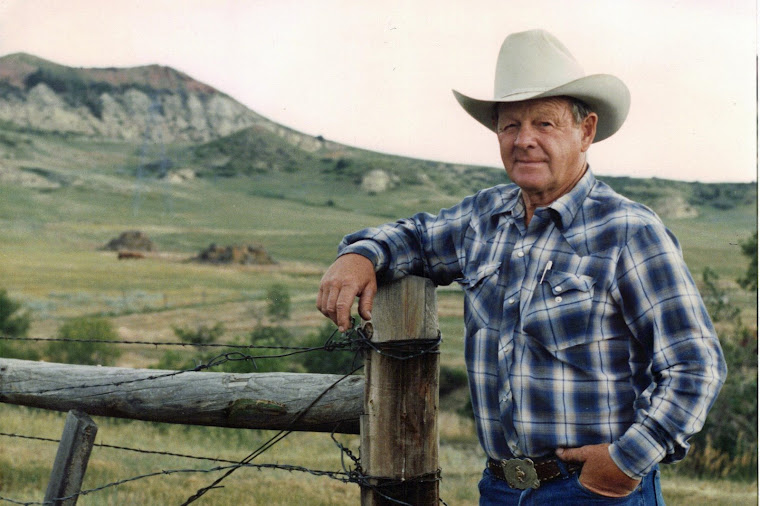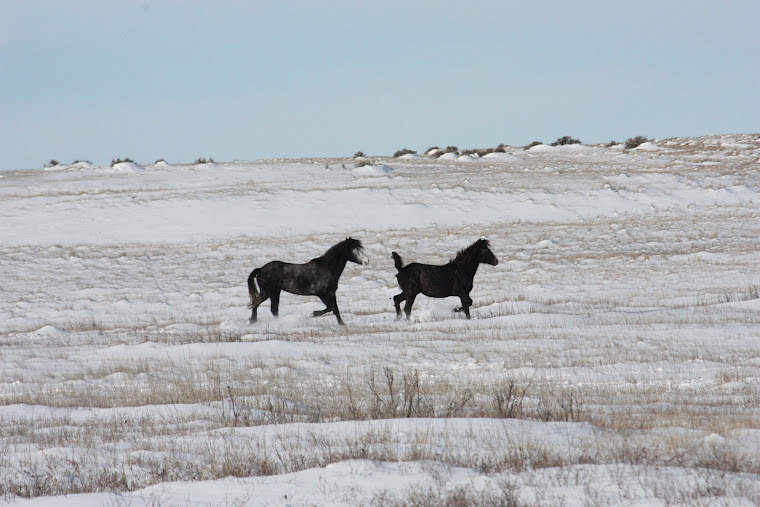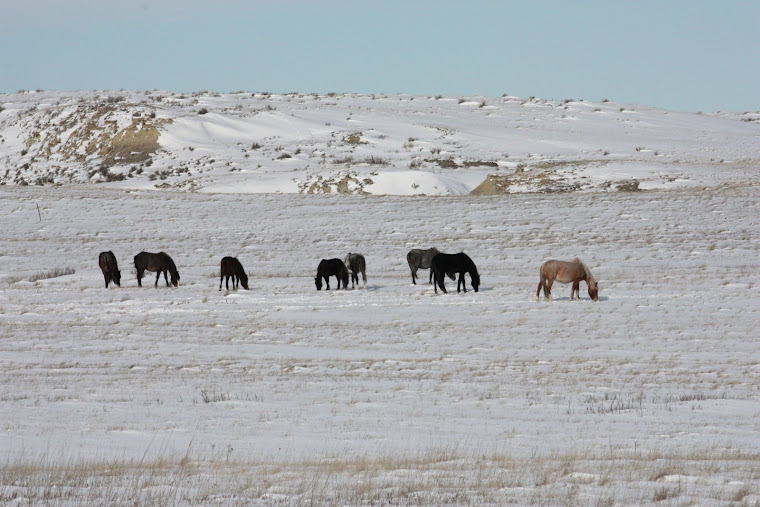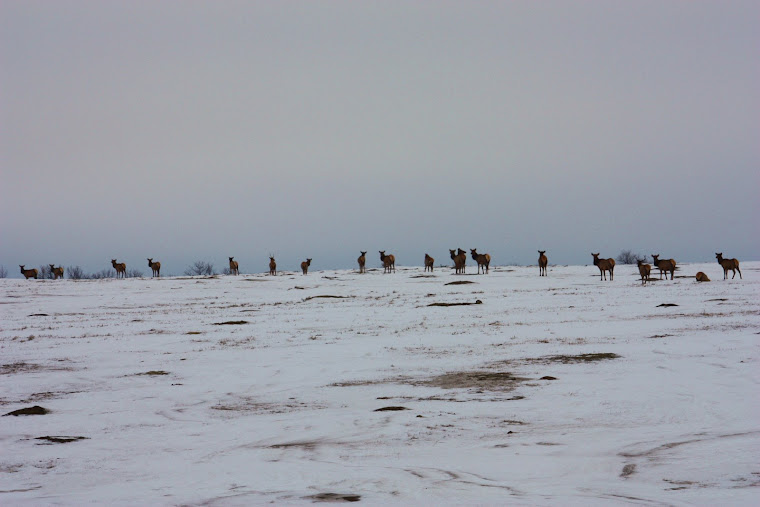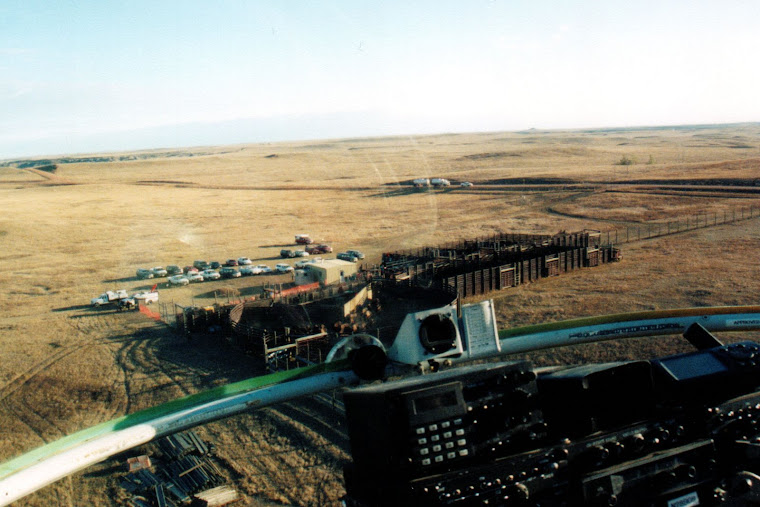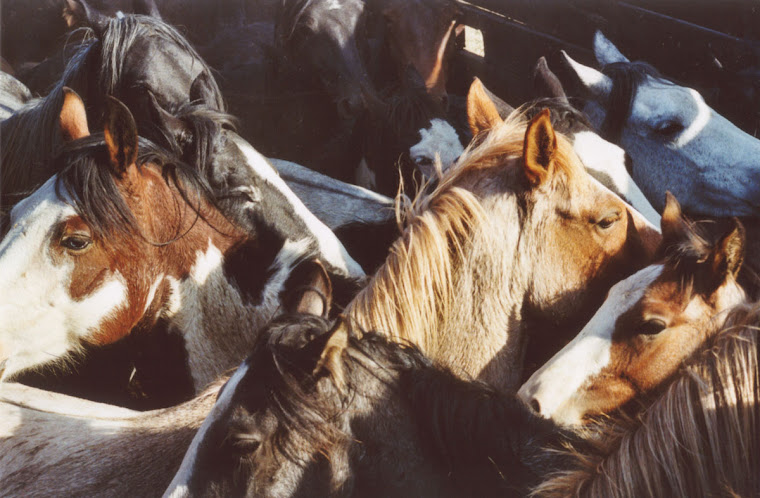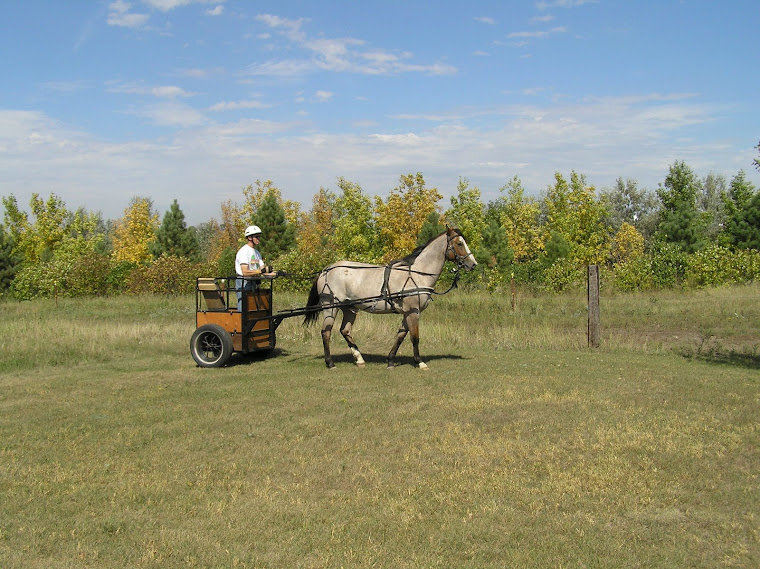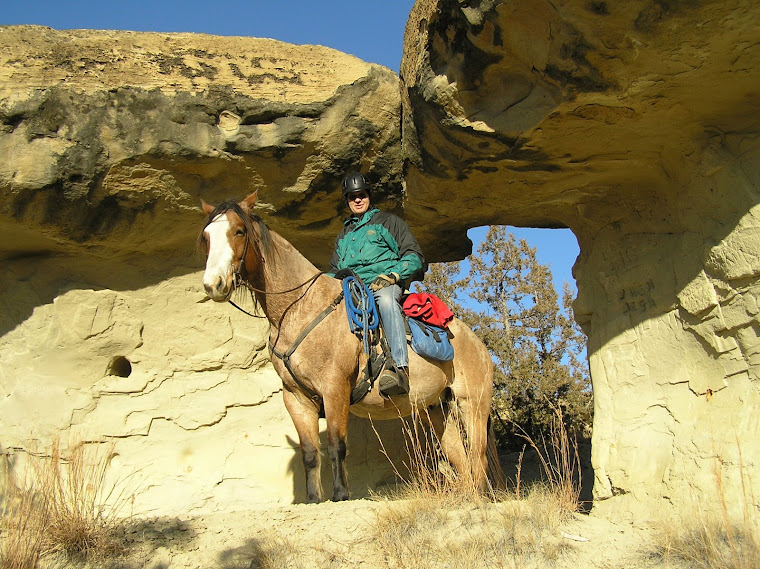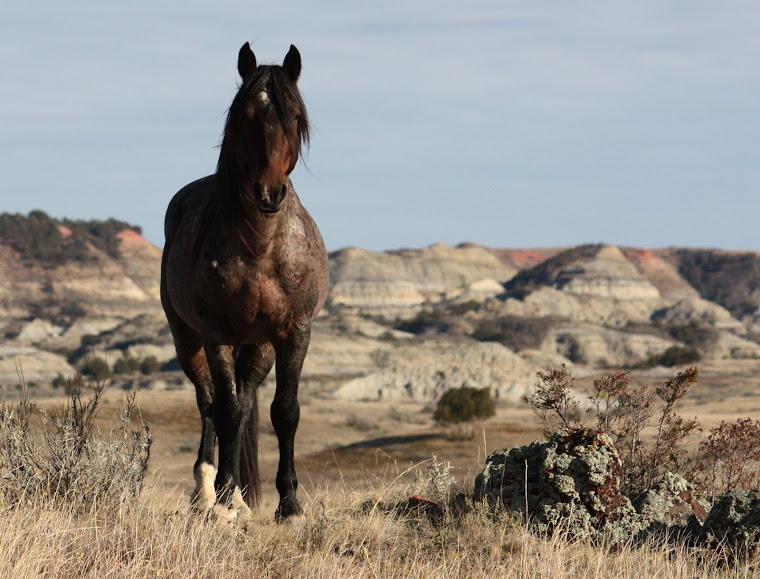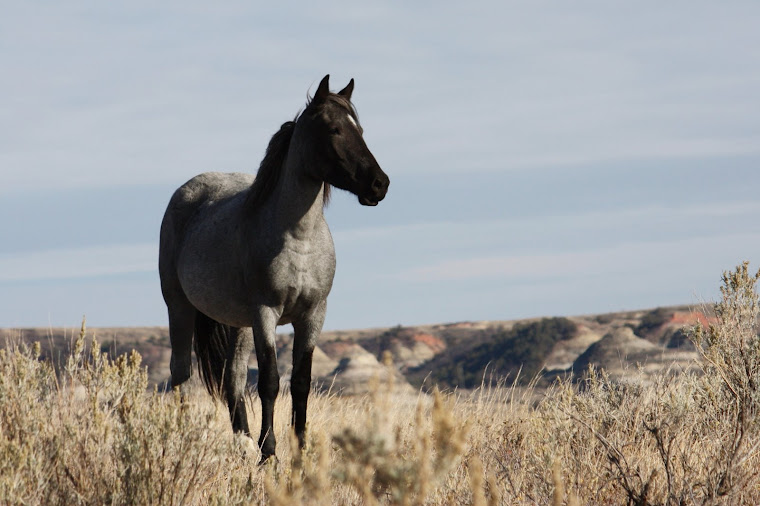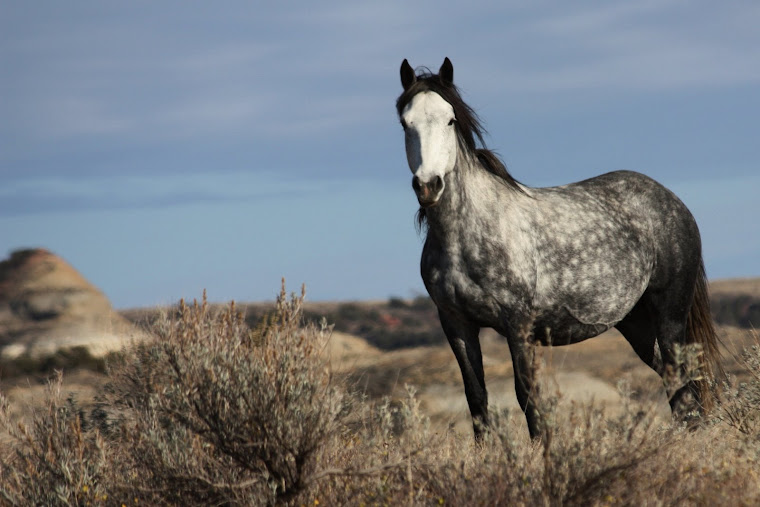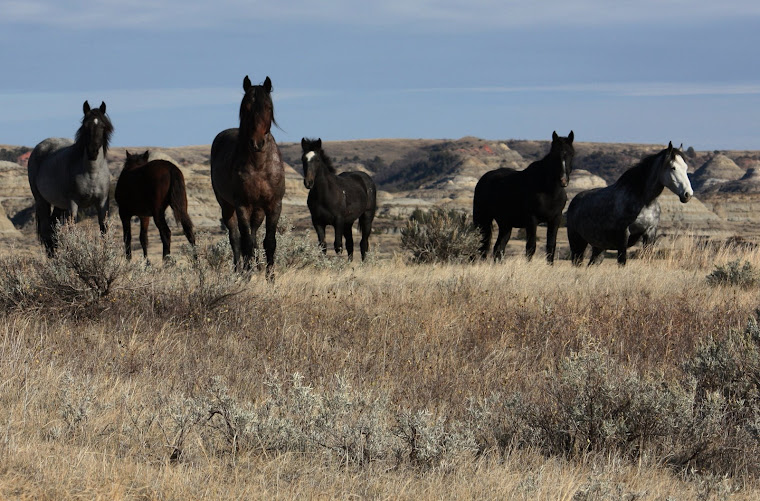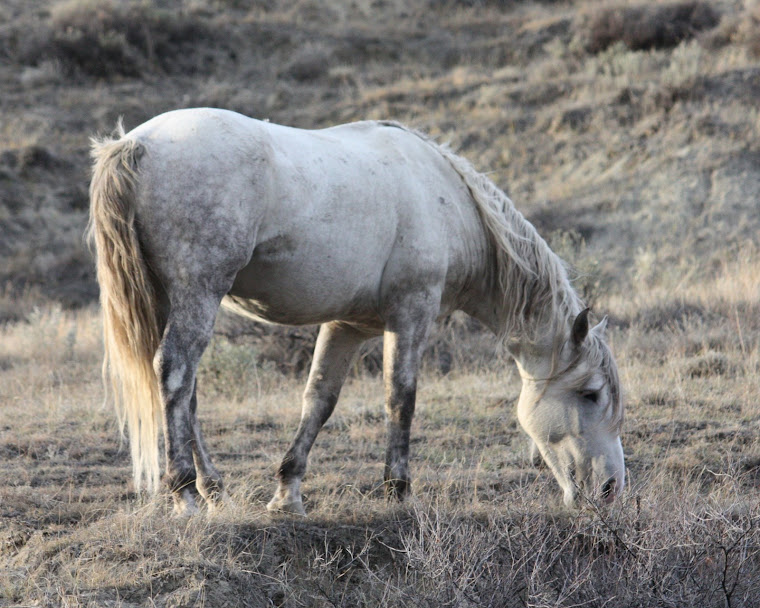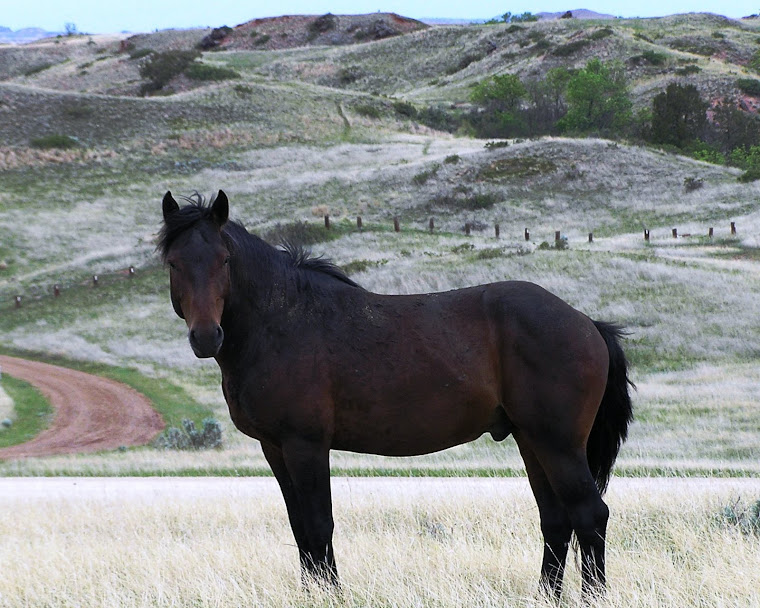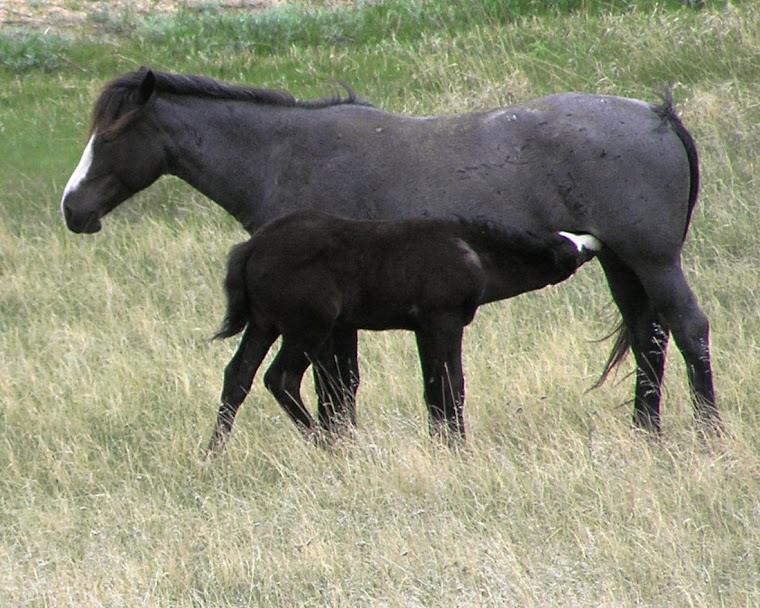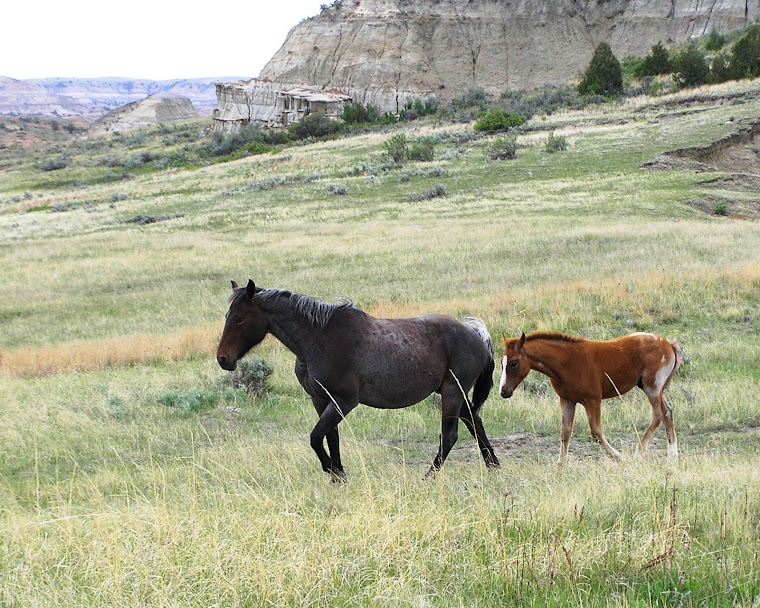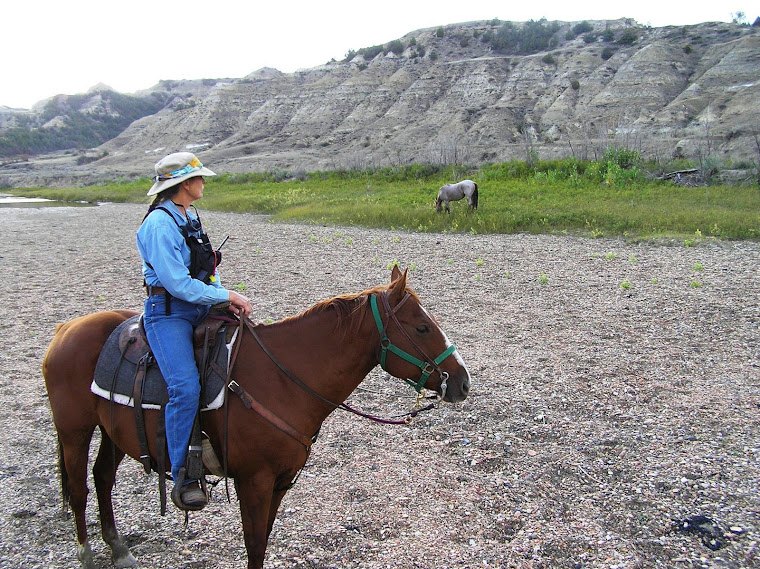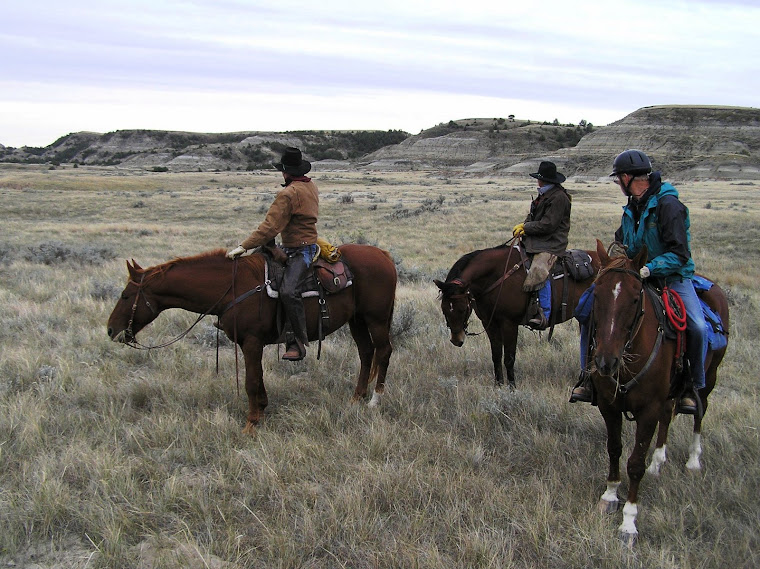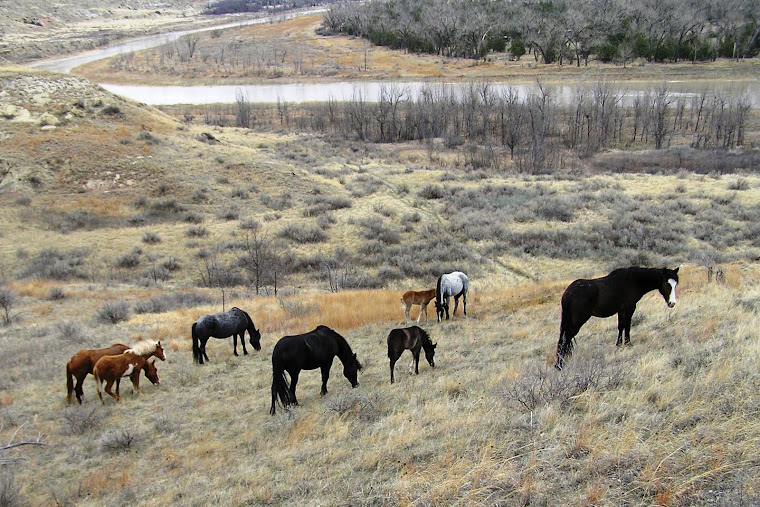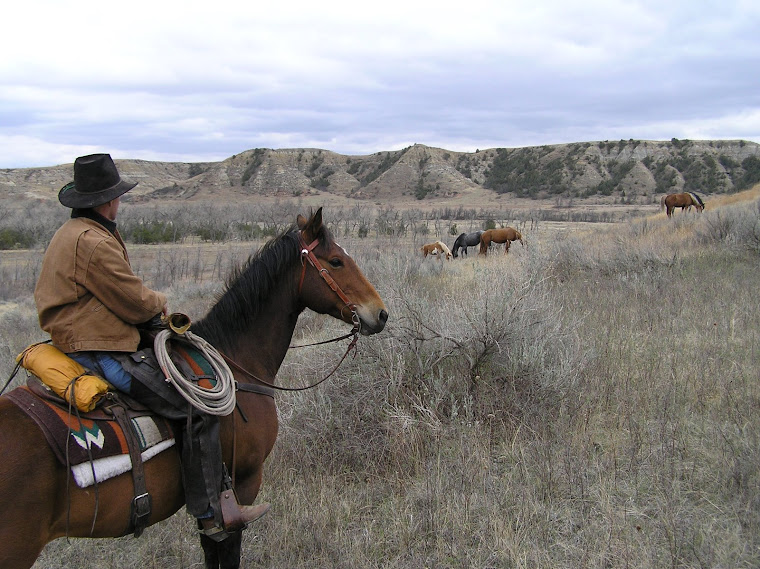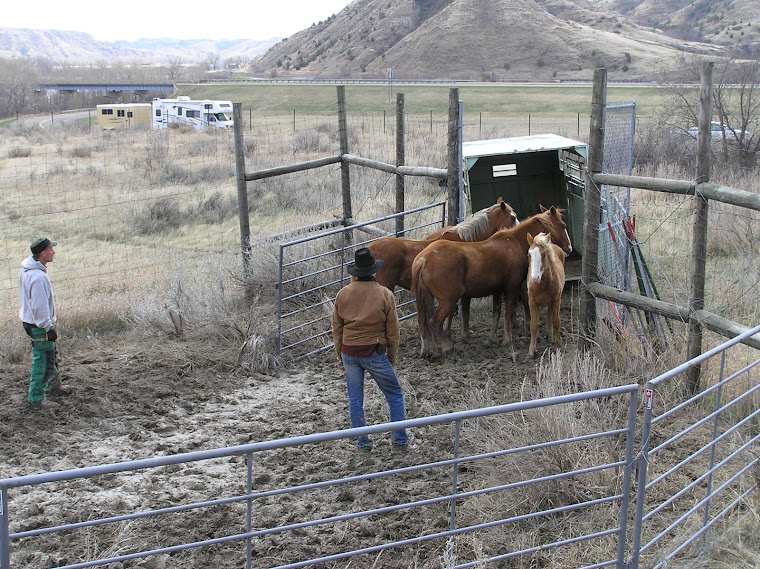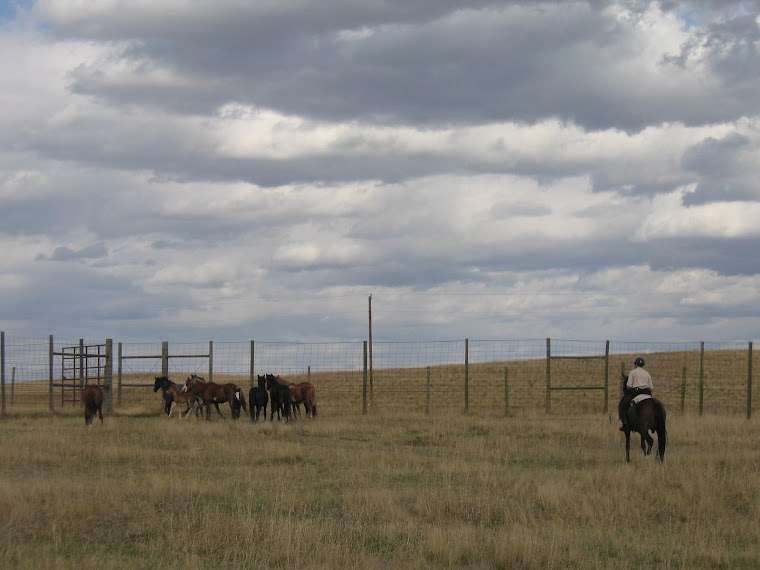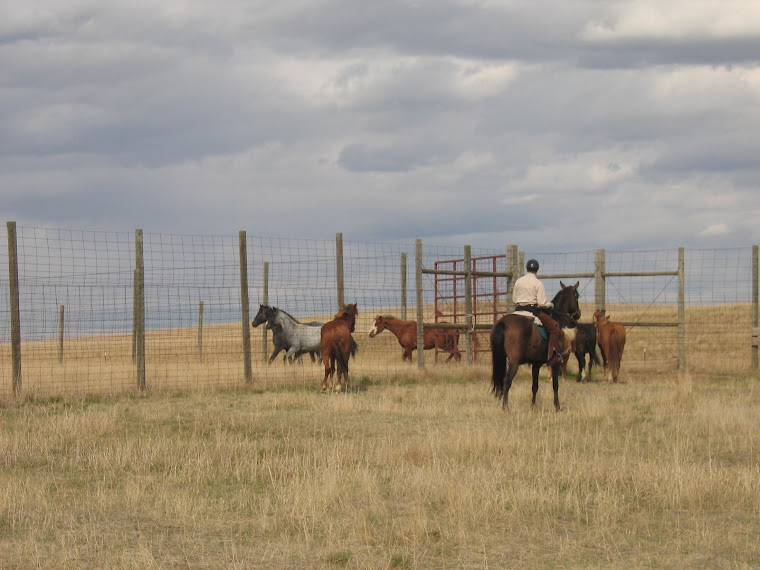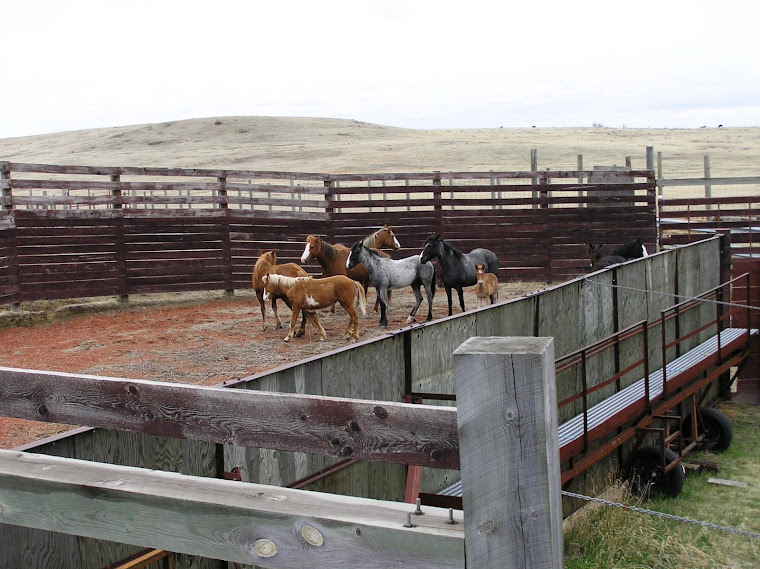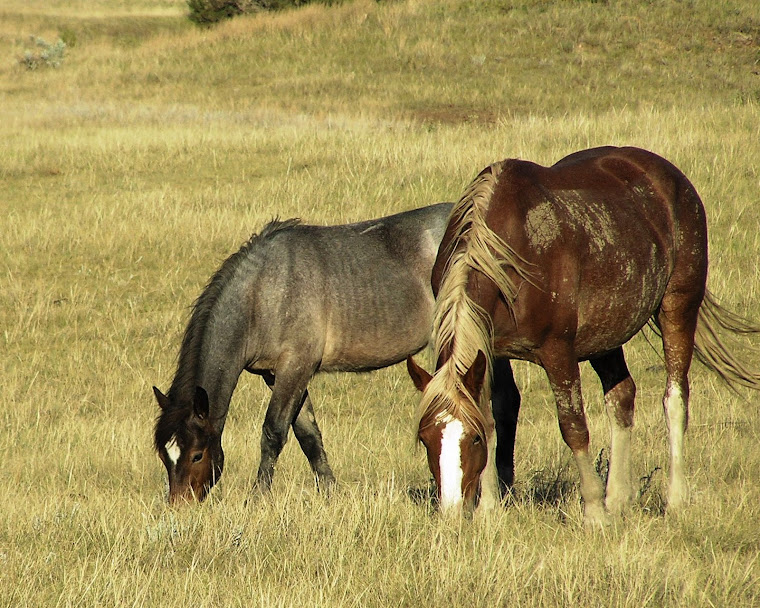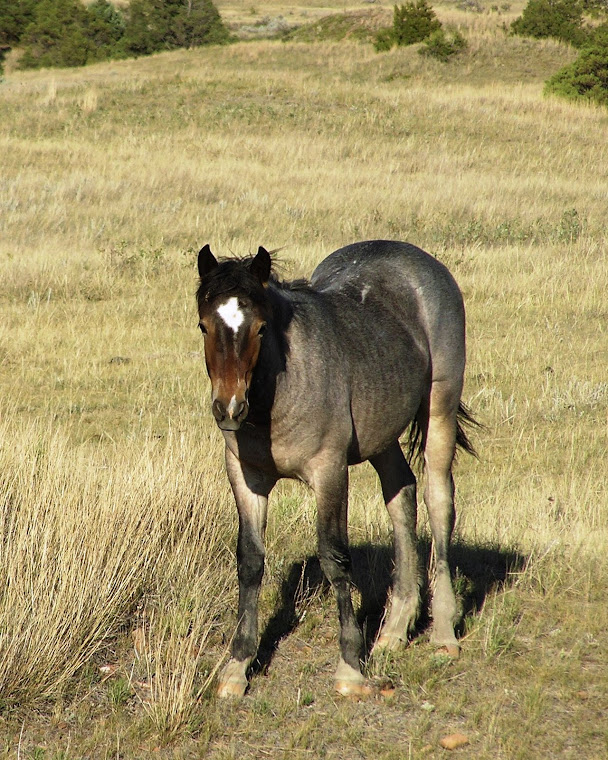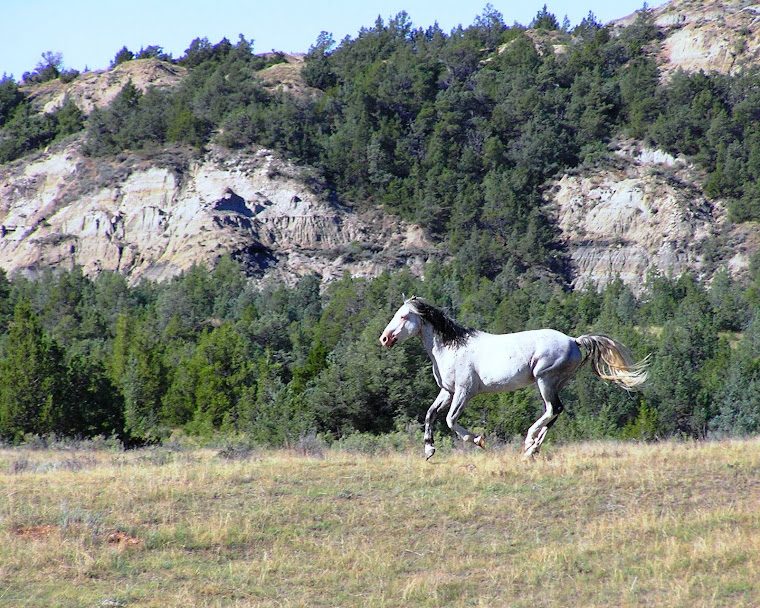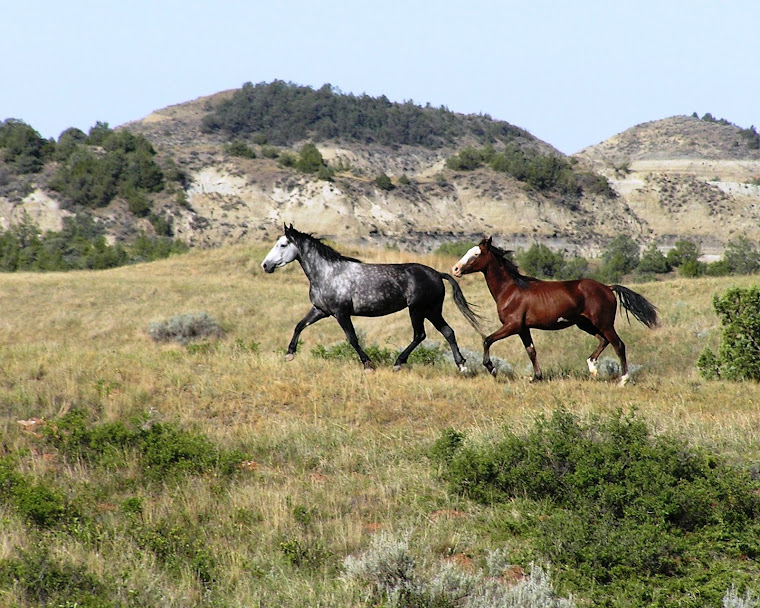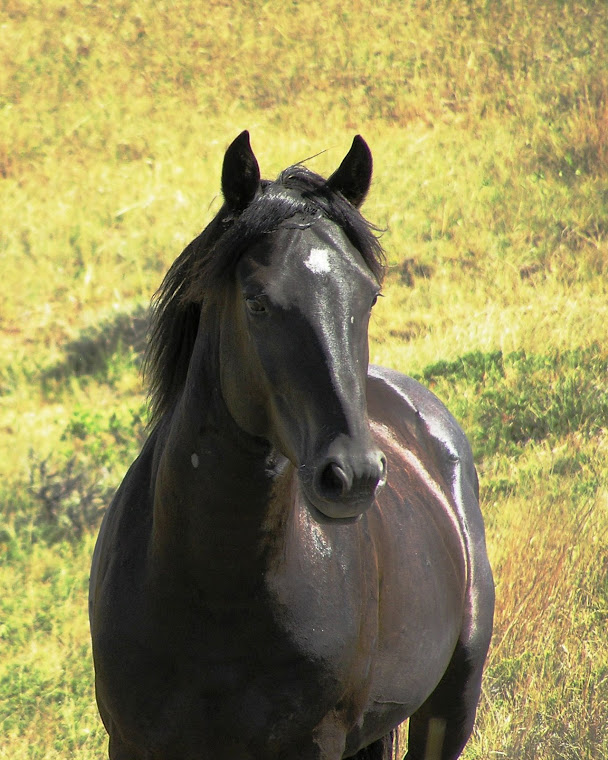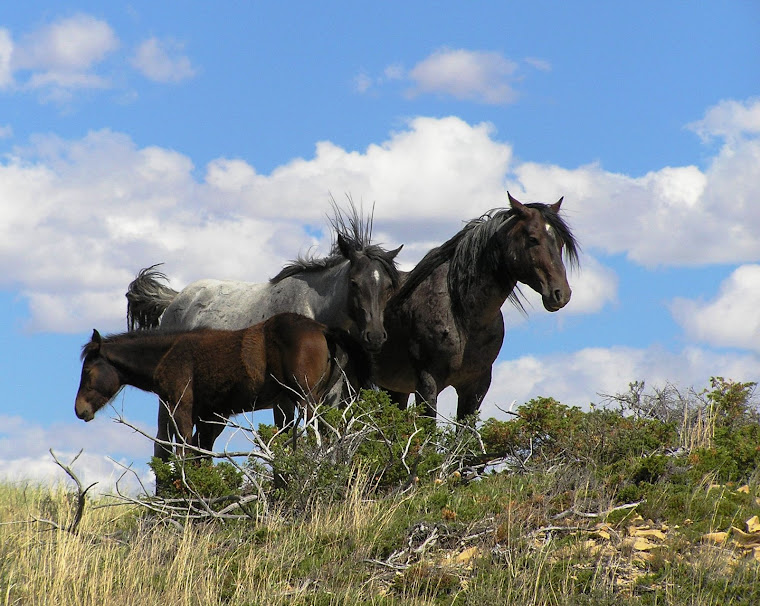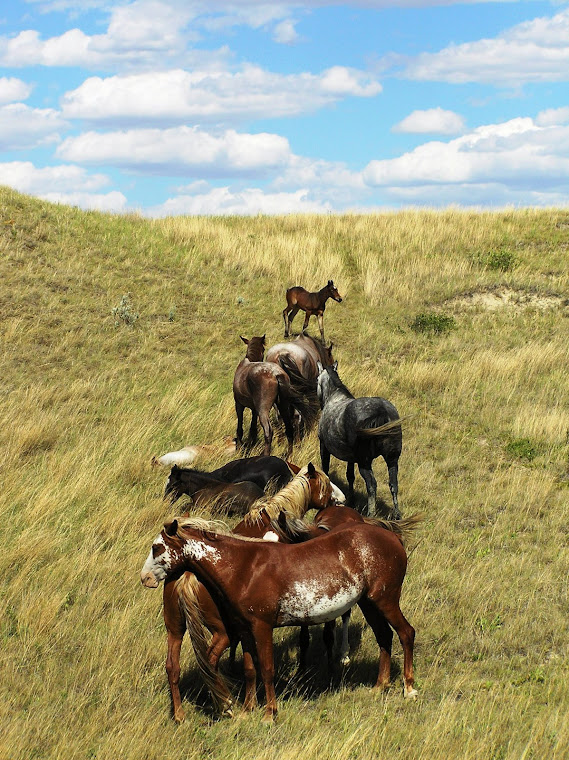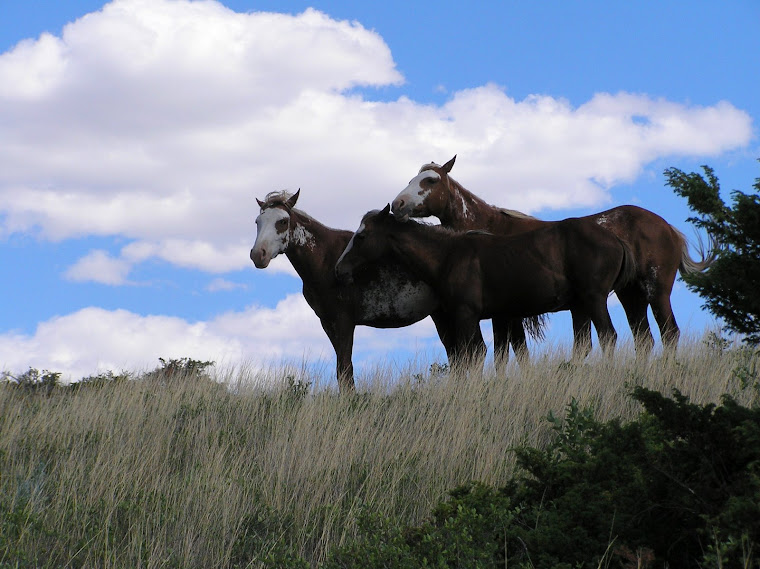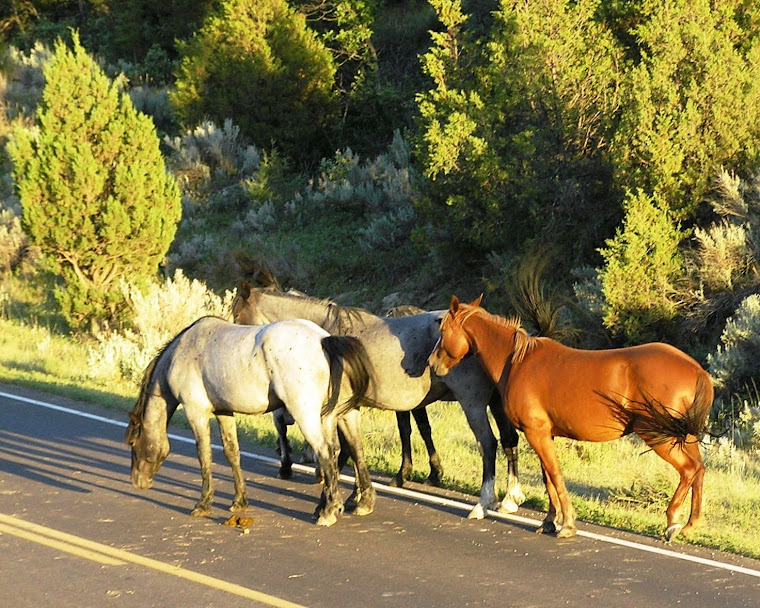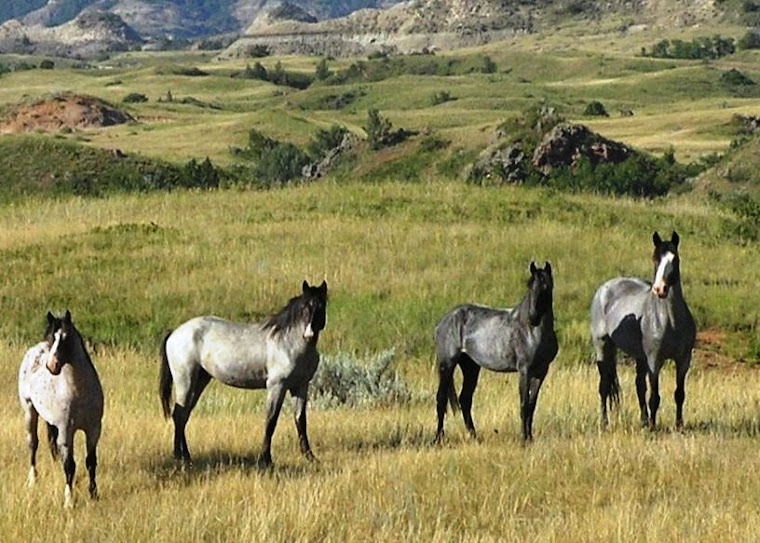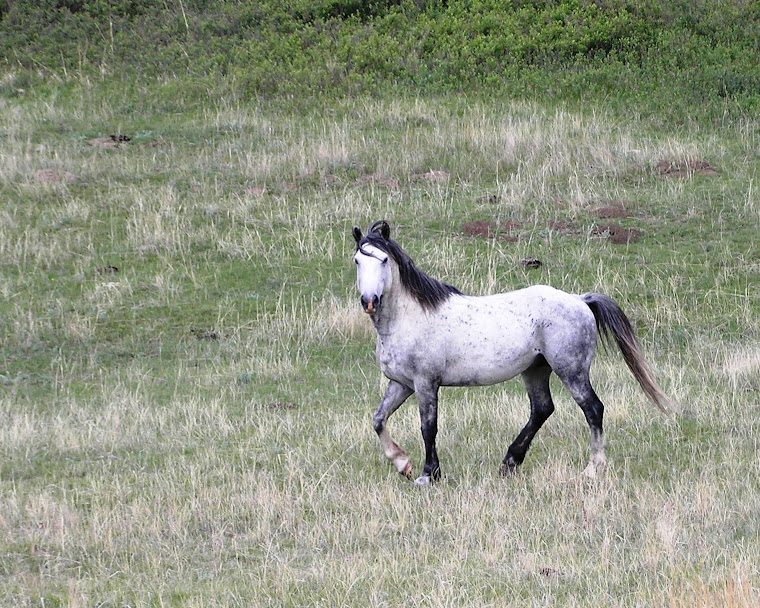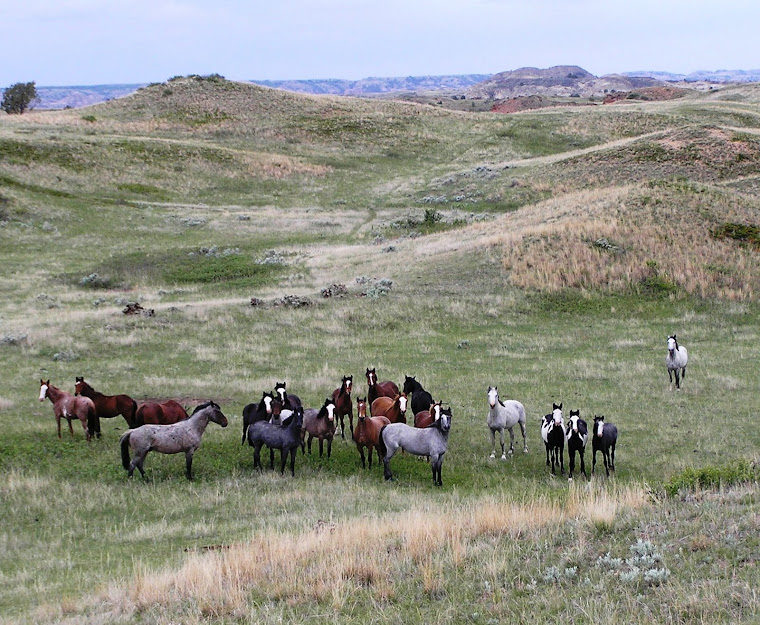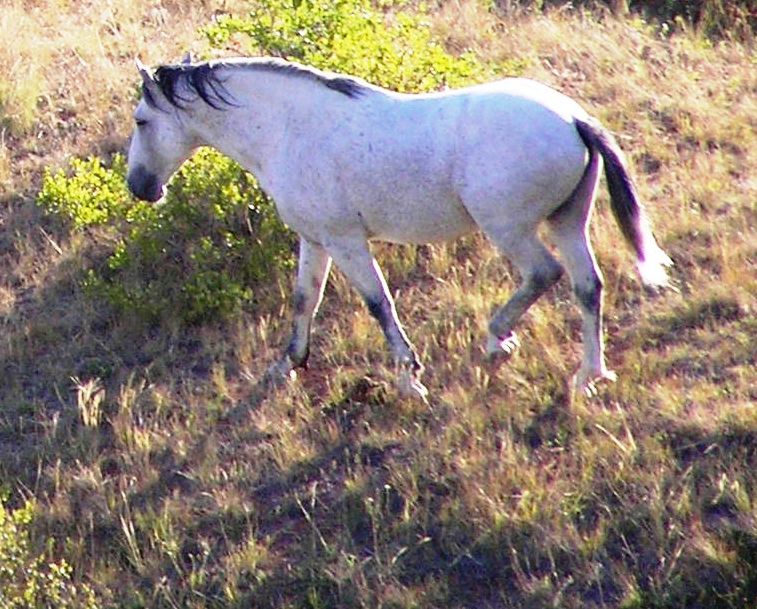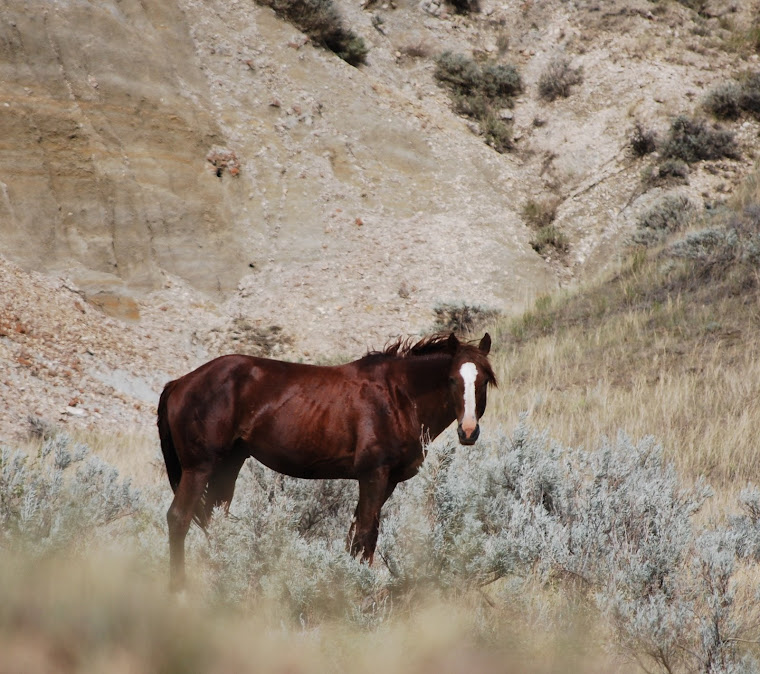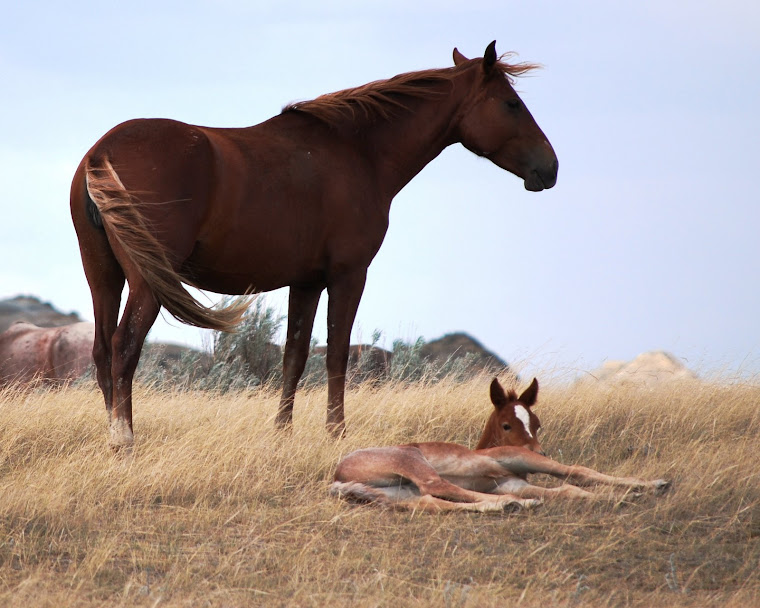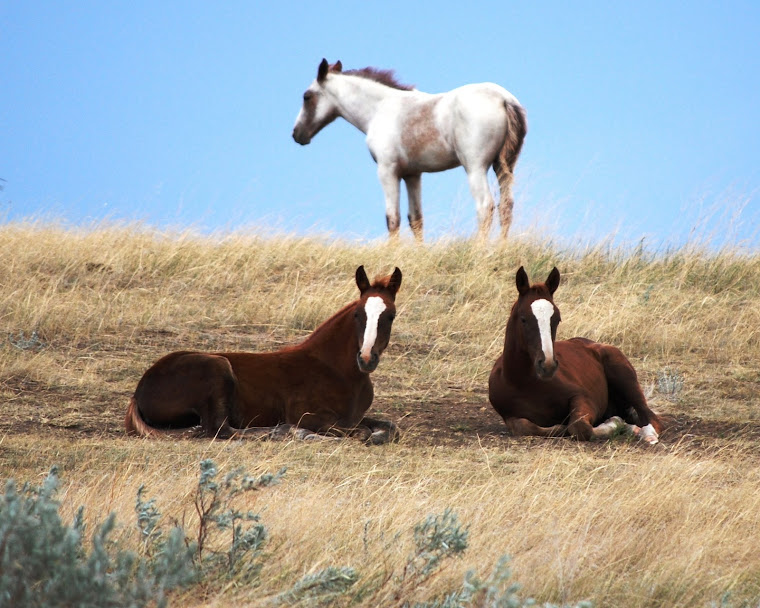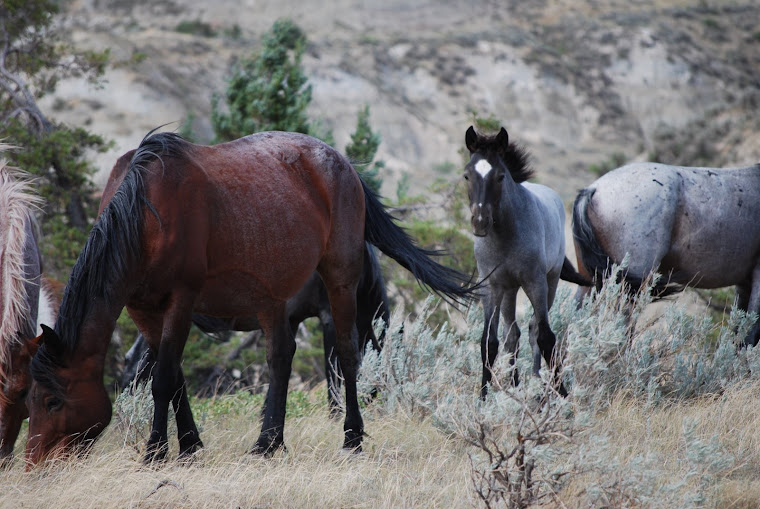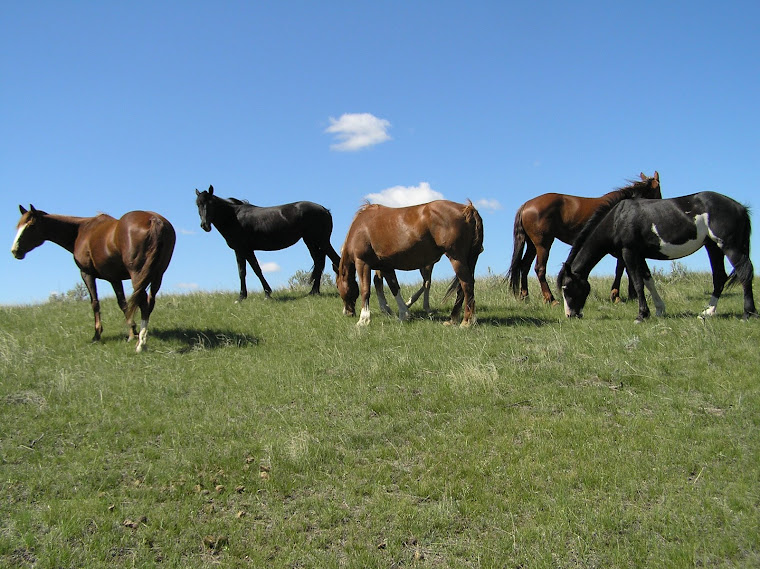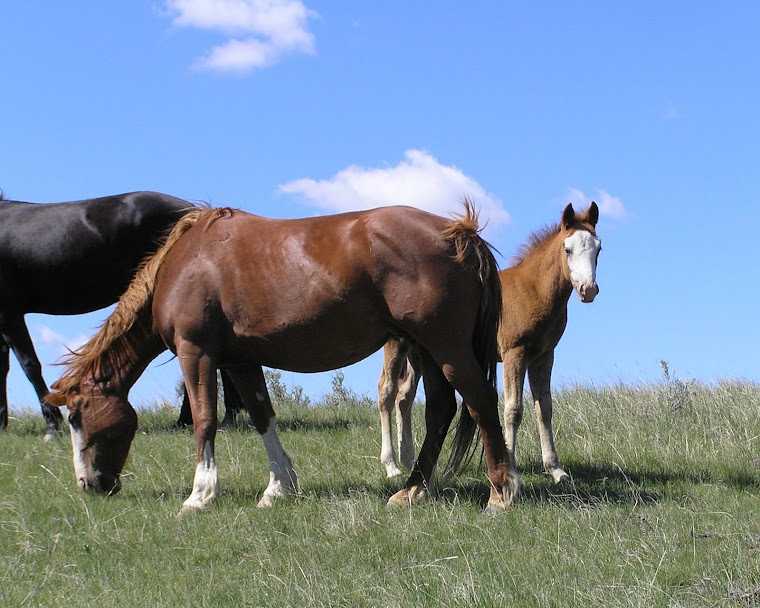The B band has roamed in the area between Interstate 94 and the south side of the park's loop road for decades, but because of their insistence on remaining in their territory and an apparent inability of stallions from other parts of the park to gain any mares in that area, the band had suffered from inbreeding more than the bands that intermingled in the rest of the park. Several of the Interstate band were culled over the years because of obvious conformation faults. In the 2000 roundup, Interestate Blue was removed because he had been the band sire for several years and produced many offspring.
In the spring of 2001, Little Sorrel, a young bachelor son of a stallion that had run in the interior of the park, collected most of the remaining mares in that area and also acquired some of the mares that remained from his sire's band. Another young stallion, originally from the Interstate band, that had run on Johnson Plateau until he was strong and mature enough, picked up mares from those same bands and established his own small band in the same area but farther to the west. Gary, a gray, became the patriarch of the gray, N band, which is often referred to by the park personnel as the "Caspers." The Rose Gray Mare and Ghost are two of the oldest mares in the park.
Little Sorrel now has the largest band in the park (18), consisting of two older mares, Grandma Roan and Tanker, two younger mares, Trouble's Girl and Gary's Gray, and generations of their offspring. The lead mare, Grandma Roan, is getting old, but still produced some of the nicest foals in the band. Her striking bay roan stud colt is one of the five new foals this year.
Thursday, July 24, 2008
Tuesday, July 22, 2008
The A Band
Tom Tescher, the rancher who recorded the horses for 50 years, developed a system for keeping track of the different bands and individual horses. Tom is not able to keep his detailed, hand written records any more, but I have continued his system because it works.
In Tom's system each band is given a letter, so first I will tell you about the A band. For the past 10 years Curious George, pictured below, has had the A band, which could be seen along the east side of the Little Missouri River, the high ground between Jones and Paddock creeks and the Paddock Creek valley. Though he carefully guarded his band from other band stallions and bachelors that would have stolen his mares, he allowed park visitors to observe and photograph the band regularly, sometimes blocking traffic as they tried to escape from the pesky flies. He has been one of the most photographed and remembered horses in the park during those years because of his unique overo spots, bald face, and amicable nature.
He created a small band of young fillies in his forth year, but lost most of them to the 2000 roundup. Since then he has acquired and stayed with the same three mares for several years. Flicka, his lead mare, joined him as a two year old and bore him a foal every year for the past eight years. Stormy spent a winter across the river after her sire and another one of his fillies were struck by lightning a few days before the 2000 roundup. She found her way back across the river that spring and delivered a stout, flashy filly who became one of Curious George's favorites. Chubby could always be found hanging around him, while Stormy made his life difficult with her cantankerous disposition.
The offspring of those three mares populated the river valley and produced additional traditional and bachelor bands. One of Curious George's most popular offspring is his loud black and white overo, Circus, who had his own band for a short while, but now remains a bachelor.
Sadly, Curious George lost his band to two other stallions this spring. He can still be seen in the Paddock Creek area and occasionally on the river bottoms hanging out with other bachelor stallions. He has regained his rich brown, shiny coat, but he has lost the proud look in his eyes.
Most of his band now runs with one of his grandsons we have named Silver. Stormy, who gave Curious George so much trouble, seems to be quite content running with a younger stallion who was also frightened across the river by the storm in the fall of 2000.
Stormy and Chubby produced healthy stud colts this year while Flicka appears to be open for the first time. Her filly from 2001, Big Red, the only daughter Curious George kept, has also not foaled. Look for photos of this band soon, at the bottom of the posts.
In Tom's system each band is given a letter, so first I will tell you about the A band. For the past 10 years Curious George, pictured below, has had the A band, which could be seen along the east side of the Little Missouri River, the high ground between Jones and Paddock creeks and the Paddock Creek valley. Though he carefully guarded his band from other band stallions and bachelors that would have stolen his mares, he allowed park visitors to observe and photograph the band regularly, sometimes blocking traffic as they tried to escape from the pesky flies. He has been one of the most photographed and remembered horses in the park during those years because of his unique overo spots, bald face, and amicable nature.
He created a small band of young fillies in his forth year, but lost most of them to the 2000 roundup. Since then he has acquired and stayed with the same three mares for several years. Flicka, his lead mare, joined him as a two year old and bore him a foal every year for the past eight years. Stormy spent a winter across the river after her sire and another one of his fillies were struck by lightning a few days before the 2000 roundup. She found her way back across the river that spring and delivered a stout, flashy filly who became one of Curious George's favorites. Chubby could always be found hanging around him, while Stormy made his life difficult with her cantankerous disposition.
The offspring of those three mares populated the river valley and produced additional traditional and bachelor bands. One of Curious George's most popular offspring is his loud black and white overo, Circus, who had his own band for a short while, but now remains a bachelor.
Sadly, Curious George lost his band to two other stallions this spring. He can still be seen in the Paddock Creek area and occasionally on the river bottoms hanging out with other bachelor stallions. He has regained his rich brown, shiny coat, but he has lost the proud look in his eyes.
Most of his band now runs with one of his grandsons we have named Silver. Stormy, who gave Curious George so much trouble, seems to be quite content running with a younger stallion who was also frightened across the river by the storm in the fall of 2000.
Stormy and Chubby produced healthy stud colts this year while Flicka appears to be open for the first time. Her filly from 2001, Big Red, the only daughter Curious George kept, has also not foaled. Look for photos of this band soon, at the bottom of the posts.
Wednesday, July 16, 2008
Current TRNP Horses
Sine the 2003 roundup, when over 70 horses were sold and 57 horses were left in the Park, their numbers have steadily grown. Last fall, a roundup was attempted, but failed due to the crash of the helicopter. No one was seriously injured, but it brought the roundup to an abrupt halt, and no horses were sold. At that time there were 127 horses of various ages. Two foals were born shortly before the mid-October roundup and one was born a week or two after. They all survived the winter.
After tracking the horses in May, June, and July, we have determined that there are approximately 135 horses in the park as of July 15th. We may still have additional foals as the summer progresses. Some adults and three foals have died since last fall and a band of 10 horses was removed in early May by a low stress livestock handler. (This story will be coming soon.)
In the next several weeks, I will attempt to introduce you to each of the 14 bands, their band stallions, lead mares, other band members, and the 14 new foals. There are also around 25 bachelor stallions roaming in loosely united bands and individually. Many of these horses have their own unique stories, so come back often to meet the wild horses of TRNP.
After tracking the horses in May, June, and July, we have determined that there are approximately 135 horses in the park as of July 15th. We may still have additional foals as the summer progresses. Some adults and three foals have died since last fall and a band of 10 horses was removed in early May by a low stress livestock handler. (This story will be coming soon.)
In the next several weeks, I will attempt to introduce you to each of the 14 bands, their band stallions, lead mares, other band members, and the 14 new foals. There are also around 25 bachelor stallions roaming in loosely united bands and individually. Many of these horses have their own unique stories, so come back often to meet the wild horses of TRNP.
Wednesday, July 9, 2008
WILD HORSES OF THEODORE ROOSEVELT NATIONAL PARK
The horses running wild in Theodore Roosevelt National Park in western North Dakota have developed over the years into a breed unlike any other. Descendants of sturdy domestic farm horses, trusty ranch stock and the ponies that carried our Native American people across the plains, they have survived harsh North Dakota blizzards, temperatures of -40 degrees, and the scorching sun and hot dry winds of summer. They have learned to find shelter in the washes and Juniper stands of the badlands and drink from the water filled tracks of Bison after a sudden summer rain.
In the mid 1900's many wanted them dead. Hundreds were herded into rail cars and shipped away to slaughter when trains, autos, and tractors made them obsolete. Cowboys and ranchers made sport of running them down or shooting them to keep them from foraging on the rich, but often sparse grasses of the Little Missouri breaks. Early roundups were conducted on horseback, by pickup truck, and even with planes. It didn't much matter what happened to the horses during the wild chase, since they were destined for destruction anyway.
The horses that remained in the national park, once it was fenced, were the lucky ones. For many years they too were targeted for removal as trespass animals, but some survived and became the foundation of these proud and beautiful horses that call the North Dakota badlands their home.
These horses had a friend in a local rancher, who loved them, kept track of them, and managed them for decades. His story will becoming to this blog soon.

In the mid 1900's many wanted them dead. Hundreds were herded into rail cars and shipped away to slaughter when trains, autos, and tractors made them obsolete. Cowboys and ranchers made sport of running them down or shooting them to keep them from foraging on the rich, but often sparse grasses of the Little Missouri breaks. Early roundups were conducted on horseback, by pickup truck, and even with planes. It didn't much matter what happened to the horses during the wild chase, since they were destined for destruction anyway.
The horses that remained in the national park, once it was fenced, were the lucky ones. For many years they too were targeted for removal as trespass animals, but some survived and became the foundation of these proud and beautiful horses that call the North Dakota badlands their home.
These horses had a friend in a local rancher, who loved them, kept track of them, and managed them for decades. His story will becoming to this blog soon.

Subscribe to:
Posts (Atom)
